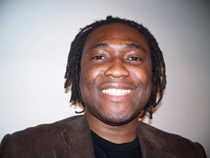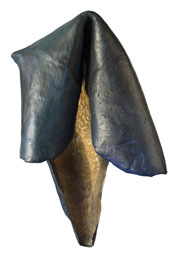P.I.: Some of your sculptures like Shadows of Domestication, Shield for a Human, Blue Bells, and a few others could pass for relics from centuries ago. Do you set out to replicate the same starkness as seen with antique objects in your work?
V.P.: No, I don’t. I am not at all interested in the “look” of my works when I start out making them. This may sound odd, but for me there is a difference between how a three-dimensional form makes sense to me as a form – as opposed to how it appears. There is the dichotomy again, that I am trying to reconcile. I try to get the form and its appearance to merge. Practically that means that I am interested in a “nature” of form. I am not interested in the surface details so much, adornments, anything that makes it timely or specific. I am interested in a timelessness. So to your question, and that is something that I have not really thought about before, all these extra elements would be what gets lost on a relic from centuries ago (or a fossil for that matter). A piece that has survived long times usually would be worn off and then reveal the basic shape, the “nature” of form, that I usually seek to find in a natural object that I look at to start my work. I do work with surfaces that show a lot of traces, but these are not traces that are put on later in order to get at a certain look. They are the literal traces and scars and the marks of the tools that I use; they happen when I make something. Most sculptors would continue and take all of these marks out. But I stop before and reveal them. In a way, I am trying to reveal in an object, in a sculpture, the history of its own making. It is essential for me that you, the viewer look at my work and know this has been made. It is not found, even if it may appear that way. I want you to start thinking about what that means conceptually for the particular object. I am not very romantic about the process of working. As for stone, I usually have it cut to a cube in specific dimensions. In plaster, I work with an armature that is very close to what the final form will be. I don’t believe in this myth, that the material talks to you and tells you what is buried inside. That is my job. I shape the material until it is right. And then I step aside and hopefully the work takes on a life of its own. I know when a sculpture is finished when I can look at it as an object that can engage me in an experience and it does not matter to me any more if I made it or not.
P.I.: Though not a dangerous activity as imagined but stone-carving and most of the concrete materials you work with could present a health and safety issue in the studio. How do you deal with this hazard?
V.P.: I am a professional. I studied what I do for many years and I have been doing it now for many years. You use common safety precautions for everything you do. I don’t think I am exposed to any extreme hazards. In a working environment you have to use a lot of common sense and you have to know what you are doing, then you will be safe.
P.I.: In his essay Eleven Theses on Sculpture published in 1997 in the Journal: Art & Design, John Letche writes about the sculptural moment to include not just a visual experience but also a tactile one. He goes on to describe this “as a moment that evokes touch as much as it entails the real touch”. Do you think this is a grandiose statement aimed at situating sculpture as an artform beyond its realm of experience?
V.P.: Unfortunately I am not familiar with this essay but I am not sure if one could consider this a “grandiose” statement. I certainly think that sculpture- good sculpture, for me, does exactly that, it opens up a meaningful encounter; something that lasts after you experienced it and changes your life. I think it is more than breaking an experience into a visual and tactile component, because for me, the word “experience” connected to art has to be used very specific. An experience for me is an encounter on a phenomenological level and it opens up a real quest and I agree that it touches a viewer in a “real” way. I use the word “experience” a lot in regard to the viewing of sculpture. It is for me opposed to the engagement with art on the level of “information”. This way of engaging with an art object is for me a way of distinguishing what I would call “sculpture” from the “sculptural” or “installation”. Installation works on the level of information. You look “at” something. You understand it and receive information, but the engagement is not a real “experience”. This is of course very specific terminology, but I think it is necessary, because it seems that people in general are not very clear about how to look at three-dimensional work. Sculpture can add to your life in a very different way than other artworks do. That is not a question of better or worse; it is just a different way of engaging with art and living with it.
P.I: Is it normal practice to go back to refine an already finished piece? When is a work of art ready for showing?
V.P.: No, not for me. I am a person that really does not go back to refinish a piece (unless there is some damage and you have to repair it). My works may look very amorphous and thus open-ended if you just briefly look at them, but they are not. They are very specific and worked very close to a model. So there is usually a very definite moment when a work is done. At that point then you step aside and it feels right. You know, when the surface does, what you want it to do.
P.I.: How does the internal structure of your work affect the shape of the surface? Do you work with ready-made casts? Kindly let us into the conception and make-up of some of your sculptures?
V.P.: That is a very interesting question, because a lot of my work feels like there is an internal structure and I of course use that very consciously in order to direct the way you engage with it; but, when I really think about it, there is no internal structure – physically – to my work. That might sound surprising. Stone is solid. Bronze is a skin. My plasters are only skins. I developed a working method that allows me to make large forms that are actually only skins. The question of skins touches the second part of your question. But I want to be precise and will dissect your term here in order to explain my approach. There is a “ready-made” and then there are casts. I work with models and maquettes, (usually very small objects), but I don’t make casts from found objects. I do make moulds of my own works, because I like using the “skins” of them to develop new shapes. So that is probably what you are referring to. I have been experimenting with that and for example my “bells” and “shadows for bells” are all a direct result of this working method. They are, literally, a cast of the surface of a different sculpture that I used in order to form new objects.
P.I.: Given the three dimensional property of a piece of sculpture, is it important to contrast the view exhibited in different dimensions with that of the preferred perspective and angle?
V.P.: No. And I am saying that so firmly, because I get often asked about the relationship between my drawings and my sculpture and it is important to me to understand that they are two different activities. I don’t think that you understand the sculpture better if I show drawings and sculpture in vicinity to each other. It may even be more confusing, but I like the dynamic between the two, especially, because my drawings are very physical and appear often to be very three-dimensional because of their scale and the surface qualities. They don’t work with a picture plane in that sense, but show objects on a plane, there is no illusion. My drawings are not illustrations of or for my sculptures; they are more of an investigation of the same idea in a different medium. They work as separate entities. I think that a lot of people nowadays don’t really know how to look at a sculpture, because they are so conditioned from Computers and TV’s to understand things as images. They seek to recognize things, they look for the information, but miss out on the experience, just because they think they should understand first what they are looking at.
I noticed too, that because of that reason a lot of people could not imagine living with a sculpture in their home.






No Comments so far ↓
There are no comments yet...Kick things off by filling out the form below.